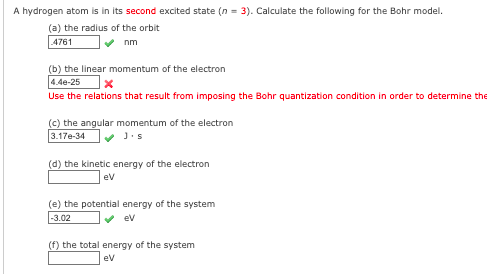A hydrogen atom is in its second excited state (n = 3). Calculate the folowing for the Bohr model. (a) the radius of the orbit 4761 v nm (b) the linear momentum of the electron 4.4e-25 Use the relations that result from imposing the Bohr quantization condition in order to determine th (c) the angular momentum of the electron 3.17e-34 v J.s (d) the kinetic energy of the electron ev (e) the potential energy of the system -3.02 ev (f) the total energy of the system ev
A hydrogen atom is in its second excited state (n = 3). Calculate the folowing for the Bohr model. (a) the radius of the orbit 4761 v nm (b) the linear momentum of the electron 4.4e-25 Use the relations that result from imposing the Bohr quantization condition in order to determine th (c) the angular momentum of the electron 3.17e-34 v J.s (d) the kinetic energy of the electron ev (e) the potential energy of the system -3.02 ev (f) the total energy of the system ev
Chemistry: An Atoms First Approach
2nd Edition
ISBN:9781305079243
Author:Steven S. Zumdahl, Susan A. Zumdahl
Publisher:Steven S. Zumdahl, Susan A. Zumdahl
Chapter2: Atomic Structure And Periodicity
Section: Chapter Questions
Problem 66E: Consider an electron for a hydrogen atom in an excited state. The maximum wavelength of...
Related questions
Concept explainers
Atomic Structure
The basic structure of an atom is defined as the component-level of atomic structure of an atom. Precisely speaking an atom consists of three major subatomic particles which are protons, neutrons, and electrons. Many theories have been stated for explaining the structure of an atom.
Shape of the D Orbital
Shapes of orbitals are an approximate representation of boundaries in space for finding electrons occupied in that respective orbital. D orbitals are known to have a clover leaf shape or dumbbell inside where electrons can be found.
Question
100%

Transcribed Image Text:A hydrogen atom is in its second excited state (n = 3). Calculate the following for the Bohr model.
(a) the radius of the orbit
4761
nm
(b) the linear momentum of the electron
4.4e-25
Use the relations that result from imposing the Bohr quantization condition in order to determine the
(c) the angular momentum of the electron
3.17e-34
(d) the kinetic energy of the electron
ev
(e) the potential energy of the system
-3.02
ev
(f) the total energy of the system
ev
Expert Solution
This question has been solved!
Explore an expertly crafted, step-by-step solution for a thorough understanding of key concepts.
This is a popular solution!
Trending now
This is a popular solution!
Step by step
Solved in 3 steps with 3 images

Knowledge Booster
Learn more about
Need a deep-dive on the concept behind this application? Look no further. Learn more about this topic, chemistry and related others by exploring similar questions and additional content below.Recommended textbooks for you

Chemistry: An Atoms First Approach
Chemistry
ISBN:
9781305079243
Author:
Steven S. Zumdahl, Susan A. Zumdahl
Publisher:
Cengage Learning


Chemistry
Chemistry
ISBN:
9781305957404
Author:
Steven S. Zumdahl, Susan A. Zumdahl, Donald J. DeCoste
Publisher:
Cengage Learning

Chemistry: An Atoms First Approach
Chemistry
ISBN:
9781305079243
Author:
Steven S. Zumdahl, Susan A. Zumdahl
Publisher:
Cengage Learning


Chemistry
Chemistry
ISBN:
9781305957404
Author:
Steven S. Zumdahl, Susan A. Zumdahl, Donald J. DeCoste
Publisher:
Cengage Learning

Chemistry: Principles and Practice
Chemistry
ISBN:
9780534420123
Author:
Daniel L. Reger, Scott R. Goode, David W. Ball, Edward Mercer
Publisher:
Cengage Learning

Chemistry: The Molecular Science
Chemistry
ISBN:
9781285199047
Author:
John W. Moore, Conrad L. Stanitski
Publisher:
Cengage Learning

Principles of Modern Chemistry
Chemistry
ISBN:
9781305079113
Author:
David W. Oxtoby, H. Pat Gillis, Laurie J. Butler
Publisher:
Cengage Learning